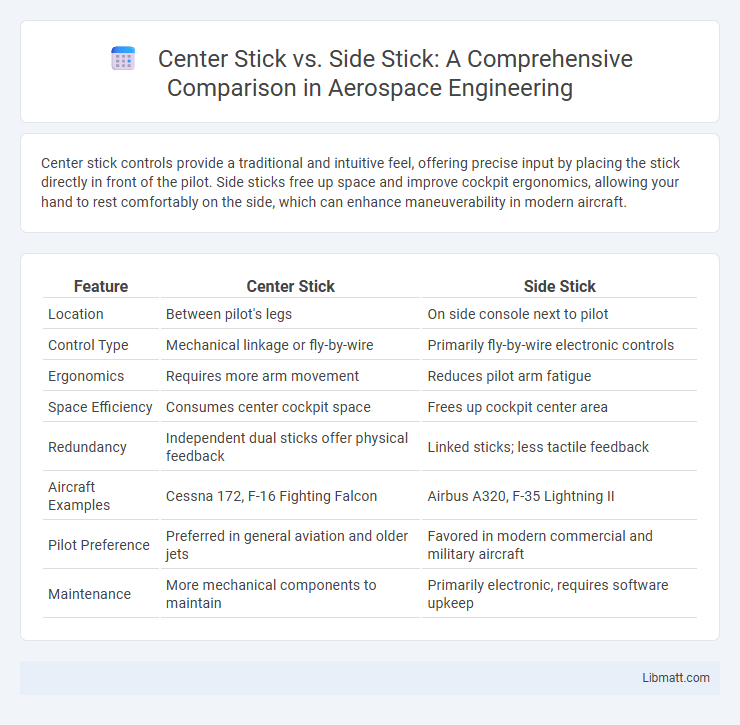Center stick controls provide a traditional and intuitive feel, offering precise input by placing the stick directly in front of the pilot. Side sticks free up space and improve cockpit ergonomics, allowing your hand to rest comfortably on the side, which can enhance maneuverability in modern aircraft.
Table of Comparison
| Feature | Center Stick | Side Stick |
|---|---|---|
| Location | Between pilot's legs | On side console next to pilot |
| Control Type | Mechanical linkage or fly-by-wire | Primarily fly-by-wire electronic controls |
| Ergonomics | Requires more arm movement | Reduces pilot arm fatigue |
| Space Efficiency | Consumes center cockpit space | Frees up cockpit center area |
| Redundancy | Independent dual sticks offer physical feedback | Linked sticks; less tactile feedback |
| Aircraft Examples | Cessna 172, F-16 Fighting Falcon | Airbus A320, F-35 Lightning II |
| Pilot Preference | Preferred in general aviation and older jets | Favored in modern commercial and military aircraft |
| Maintenance | More mechanical components to maintain | Primarily electronic, requires software upkeep |
Introduction to Center Stick and Side Stick Controls
Center stick controls, commonly used in traditional aircraft, offer pilots direct tactile feedback and intuitive handling by positioning the control stick centrally between the pilot's legs. Side stick controls, favored in modern fly-by-wire systems like those in Airbus aircraft, are located on the side console, allowing for increased cockpit space and often providing digital input signals rather than mechanical linkages. Understanding the differences in response, ergonomics, and pilot workload between center stick and side stick controls can significantly impact your flight experience and control precision.
Evolution of Aircraft Control Systems
The evolution of aircraft control systems has transitioned from traditional center sticks to modern side sticks, enhancing pilot ergonomics and cockpit space utilization. Side sticks offer more intuitive control inputs and improved accessibility in fly-by-wire systems, contributing to safer and more efficient flight operations. Your choice between center stick and side stick depends on aircraft design preferences and operational requirements.
Design and Ergonomics Comparison
Center sticks feature a vertical control positioned directly in front of the pilot, promoting natural hand placement and intuitive control movements ideal for traditional cockpit layouts. Side sticks, mounted to the cockpit side panel, allow more cockpit space and improved pilot visibility but require adaptation to non-traditional hand positioning that emphasizes wrist movement. Ergonomically, center sticks offer a more symmetrical grip and force feedback, while side sticks reduce physical fatigue by enabling a relaxed arm posture during extended flight operations.
Pilot Workload and Comfort
Center sticks offer pilots a more natural hand position that can reduce fatigue during long flights, enhancing comfort and control. Side sticks, commonly found in modern fly-by-wire aircraft, free up cockpit space and allow for easier access to other controls, but may increase pilot workload due to less tactile feedback. Your choice between these control sticks impacts both physical comfort and the cognitive effort required to manage the aircraft efficiently.
Response and Precision of Control Inputs
Center sticks offer direct mechanical linkage to control surfaces, providing highly precise and immediate response beneficial for aerobatics and tight maneuvers. Side sticks rely on electronic fly-by-wire systems that interpret pilot inputs, which may introduce minimal latency but enhance stability and control by filtering unintended movements. The choice impacts the pilot's tactile feedback and control accuracy, with center sticks favored in traditional control setups and side sticks preferred in modern aircraft for ergonomic efficiency.
Cockpit Space and Instrument Layout
Center sticks maximize cockpit space by positioning the control centrally, allowing for more streamlined instrument panels and easier access to surrounding controls. Side sticks free up even more cockpit room, enabling larger instrument clusters and improved ergonomic arrangements for your instruments and avionics. This layout enhances pilot comfort and optimizes the workflow by reducing clutter and improving reachability in the cockpit environment.
Safety and Redundancy Considerations
Center stick controls provide pilots with direct tactile feedback and promote intuitive coordination during critical flight phases, enhancing safety through straightforward manipulation. Side sticks, typically found in fly-by-wire systems, improve cockpit ergonomics but rely heavily on electronic redundancy and advanced software to prevent control conflicts and ensure reliability. Your choice between center stick and side stick hinges on prioritizing direct mechanical feedback versus sophisticated electronic safeguards for optimal redundancy and safety.
Aircraft Types: Common Applications
Center sticks are predominantly used in smaller general aviation aircraft and aerobatic planes, offering pilots direct control feedback and a compact cockpit layout. Side sticks are commonly found in modern commercial airliners and advanced military jets, providing ergonomic benefits and allowing for more cockpit space and easier instrument access. The choice between center stick and side stick often reflects the aircraft's size, mission profile, and pilot interface design preferences.
Pilot Training and Adaptation
Pilot training for center stick controls emphasizes traditional hand positioning and muscle memory, promoting a tactile and intuitive flying experience. Side stick training requires adaptation to digital input and less physical feedback, demanding increased reliance on visual and instrument cues. Your ability to transition between these control systems enhances situational awareness and flight precision in varied cockpit environments.
Future Trends in Control Stick Technology
Future trends in control stick technology emphasize integration of advanced haptic feedback and adaptive resistance to enhance pilot precision and situational awareness. Innovations include compact, modular designs that improve cockpit ergonomics and reduce weight, supporting both center stick and side stick configurations. Your experience will benefit from increased customization options and seamless interface with augmented reality systems, driving the evolution of next-generation flight control systems.
Center Stick vs Side Stick Infographic

 libmatt.com
libmatt.com